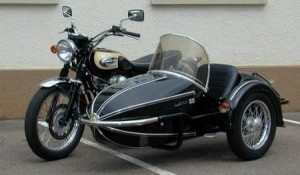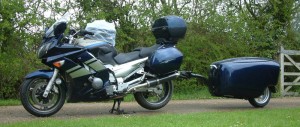Following a number of enquiries relating to use of sidecars and the towing of trailers, we’re happy to bring you the following clarification.
The relevant legislation can be found in S.I. No. 5 of 2003, the imaginatively titled “Road Traffic (Construction and Use of Vehicles) Regulations, 2003”.
Rather than simply reproducing that here, we’ve put together the following summary with the assistance of the RSA. The relevant text from the legislation can be found further down this page.
First the basics:
- A motorcycle may not be used to draw any passenger in a trailer.
- A motorcycle may not be used to draw a trailer with an unladen weight exceeding 250 kilograms.
- A motorcycle may not be used to draw more than one trailer.
If you want to tow a trailer you can, provided that:
- The motorcycle engine is 125cc or larger.
- The overall width of the trailer does not exceed 1 metre.
- The distance between the rear axle of the motorcycle and the back of the trailer does not exceed 2.5 metres.
- The motorcycle is clearly labeled to indicate the weight of the heaviest trailer which it’s designed to tow, or two thirds of the weight of the motorcycle in running order, whichever is less.
- The laden weight of the trailer does not exceed 150 kilograms or the weight specified by the manufacturer, whichever is less.
These conditions also apply to motorcycles fitted with sidecars.

Motorcycle and Trailer.
Image credit: www.mono-trail.co.uk
If you’re particularly keen to know the background to this one, or you simply enjoy reading legalese, read on!
Sidecars: The article dealing with motorcycle sidecars is Article 42 which states:
42.
(1) Subject to this Regulation, where a side-car is attached to a mechanically propelled bicycle, the side-car shall be –(a) fitted on the left side of the vehicle, and
(b) attached so that the wheel of the side-car is not wholly outside the space between transverse vertical planes, perpendicular to the longitudinal axis of the bicycle, passing through the extreme projecting points at the front and rear of axis of the bicycle.(2) Paragraph (1) (a) does not apply to a temporarily imported vehicle.
Trailers: The towing of trailers is dealt with in Articles 43 & 44, which state:
43.
(1) Subject to this Regulation and to Regulation 44, a mechanically propelled cycle may not be used to draw any passenger in a trailer, a trailer with an unladen weight exceeding 250 kilograms, or more than one trailer.
(2) This Regulation does not apply so as to prohibit the towing of a broken down mechanically propelled cycle with one rider on it.44.
(1) Subject to this Regulation, a mechanically propelled cycle with an engine capacity exceeding 125 cc may tow a trailer provided –(a) the overall width of the trailer does not exceed one metres,
(b) the distance between the rear axle of the mechanically propelled cycle and the rearmost part of the trailer does not exceed 2.5 metres,
(c) the mechanically propelled cycle is clearly and indelibly marked in a conspicuous and readily accessible position to indicate the weight of the heaviest trailer which the vehicle is designed to tow, or two thirds of the weight of the mechanically propelled cycle in running order, whichever is less, and
(d) the laden weight of the trailer does not exceed 150 kilograms or the weight specified in accordance with subparagraph (c), whichever is less.(2) This Regulation does not prohibit a mechanically propelled cycle, equipped with a coupling device in accordance with Chapter 10 of Directive 97/24/EC of the European Parliament and of the Council of 17 June 1997 (6) towing a trailer which does not exceed the maximum towable mass approved for that type of mechanically propelled cycle in accordance with Directive 2002/24/EC of the European Parliament and of the Council of 18 March 2002 (7) .
Original Source: http://www.irishstatutebook.ie/2003/en/si/0005.html
MAG Ireland would like to acknowledge the assistance and support of the Road Safety Authority in determining the relevant legislation and composing a summary of same.